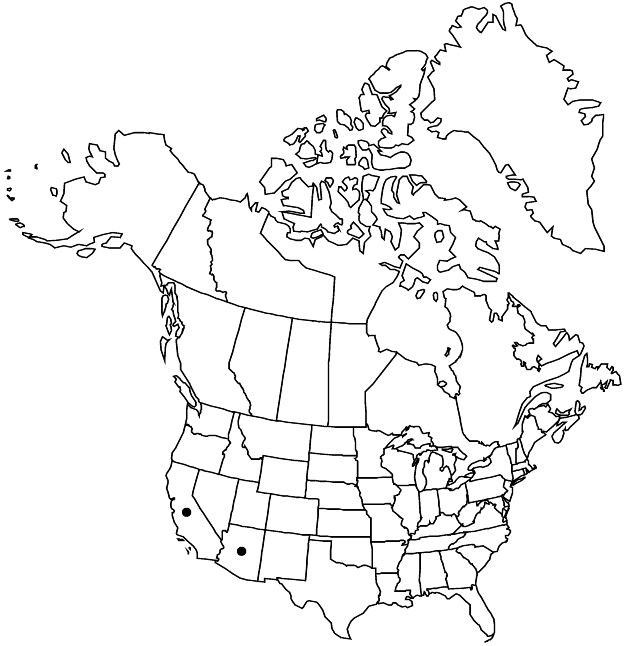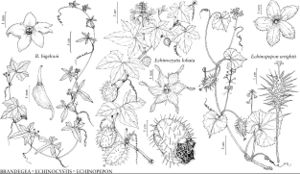Difference between revisions of "Brandegea bigelovii"
Proc. Calif. Acad. Sci., ser. 2, 3: 58. 1890.
FNA>Volume Importer |
FNA>Volume Importer |
||
| Line 19: | Line 19: | ||
|name=Brandegea monosperma | |name=Brandegea monosperma | ||
|authority=(Brandegee) Cogniaux | |authority=(Brandegee) Cogniaux | ||
| − | }}{{Treatment/ID/Synonym | + | }} {{Treatment/ID/Synonym |
|name=B. palmeri | |name=B. palmeri | ||
|authority=(S. Watson) Rose | |authority=(S. Watson) Rose | ||
| − | }}{{Treatment/ID/Synonym | + | }} {{Treatment/ID/Synonym |
|name=B. parviflora | |name=B. parviflora | ||
|authority=(S. Watson) Rose | |authority=(S. Watson) Rose | ||
| − | }}{{Treatment/ID/Synonym | + | }} {{Treatment/ID/Synonym |
|name=Vaseyanthus insularis var. palmeri | |name=Vaseyanthus insularis var. palmeri | ||
|authority=(S. Watson) Gentry | |authority=(S. Watson) Gentry | ||
| Line 43: | Line 43: | ||
|elevation=20–600(–800) m | |elevation=20–600(–800) m | ||
|distribution=Ariz.;Calif.;Mexico (Baja California;Baja California Sur;Sonora). | |distribution=Ariz.;Calif.;Mexico (Baja California;Baja California Sur;Sonora). | ||
| − | |discussion=<p>Plants of Brandegea bigelovii are cultivated for the beauty of their clusters of white staminate flowers. Garden plants in Tucson flower from February through the summer, except during extreme heat. According to R. S. Felger (2000), B. bigelovii is the most common and widespread vining plant in northwestern Sonora.</p> | + | |discussion=<p>Plants of <i>Brandegea bigelovii</i> are cultivated for the beauty of their clusters of white staminate flowers. Garden plants in Tucson flower from February through the summer, except during extreme heat. According to R. S. Felger (2000), <i>B. bigelovii</i> is the most common and widespread vining plant in northwestern Sonora.</p> |
|tables= | |tables= | ||
|references= | |references= | ||
| Line 67: | Line 67: | ||
|publication year=1890 | |publication year=1890 | ||
|special status=Selected by author to be illustrated | |special status=Selected by author to be illustrated | ||
| − | |source xml=https://jpend@bitbucket.org/aafc-mbb/fna-data-curation.git/src/ | + | |source xml=https://jpend@bitbucket.org/aafc-mbb/fna-data-curation.git/src/8f726806613d60c220dc4493de13607dd3150896/coarse_grained_fna_xml/V6/V6_23.xml |
|genus=Brandegea | |genus=Brandegea | ||
|species=Brandegea bigelovii | |species=Brandegea bigelovii | ||
Revision as of 17:46, 18 September 2019
Vines sprawling, trailing, or climbing over associated plants, often completely covering them, stems to 2(–4) m. Leaves: petiole 8–25 mm; blade 1.5–5(–7) cm, base cordate to convex, lobes broader and shallower on juvenile growth, narrower (to linear-oblong) on distal stems, abaxial surface glabrous, adaxial surface and margins pustulate-scabrous to pustulate-hirsutulous. Staminate inflorescences 2–4 cm. Capsules 0.5–1.2 cm, beak (3–)4–7 mm. Seeds 4–5 mm.
Phenology: Flowering (Feb–)Mar–Apr(–later sporadically).
Habitat: Desert wash bottoms and banks, cliffs, canyons, moist areas from tank seeps, roadsides, Larrea flats, Sonoran desert scrub, upland Sonoran desert scrub, desert riparian zones, commonly with Acacia, Ambrosia, Atriplex, Cercidium, Larrea, Lycium, Olneya, Parkinsonia, Prosopis
Elevation: 20–600(–800) m
Distribution

Ariz., Calif., Mexico (Baja California, Baja California Sur, Sonora).
Discussion
Plants of Brandegea bigelovii are cultivated for the beauty of their clusters of white staminate flowers. Garden plants in Tucson flower from February through the summer, except during extreme heat. According to R. S. Felger (2000), B. bigelovii is the most common and widespread vining plant in northwestern Sonora.
Selected References
None.
